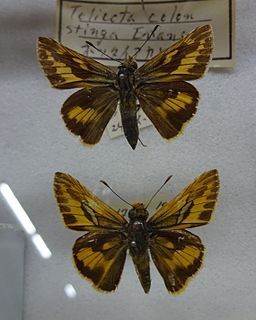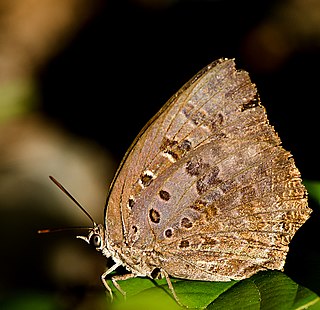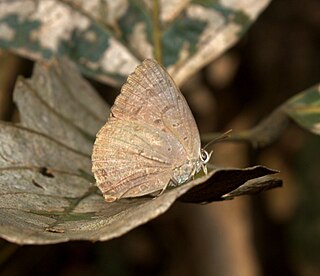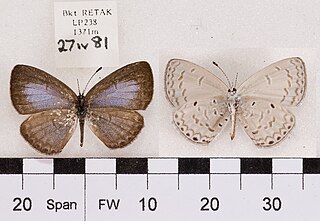Related Research Articles

Ampittia dioscorides, the common bush hopper or simply bush hopper, is a butterfly found in India, China, Indochina, Cambodia and on to Borneo, Sumatra and Java belonging to the family Hesperiidae.

Suastus gremius, the Indian palm bob or palm bob, is a butterfly belonging to the family Hesperiidae. It is found in the Indomalayan realm.

Telicota colon, commonly known as the pale palm dart or common palm dart, is a butterfly belonging to the family Hesperiidae found in India to Australia.

Chilades parrhasius, the small Cupid, is a small butterfly that belongs to the lycaenids or blues family. It is found in Nepal,southern Turan, southern Ghissar, Iran, Afghanistan, Pakistan, Sri Lanka and southern, central and north-west India.
Ionolyce helicon, the pointed lineblue, or bronze lineblue, is a small butterfly found in the Indomalayan realm that belongs to the lycaenids or blues family.

Arhopala amantes, the large oakblue, is a species of lycaenid or blue butterfly found in Asia.

Arhopala abseus, the aberrant oakblue or aberrant bushblue, is a species of lycaenid or blue butterfly found in Asia.

Arhopala atrax, the dark broken-band oakblue or Indian oakblue, is a species of lycaenid or blue butterfly found in the Indomalayan realm.

Arhopala centaurus, the centaur oakblue or dull oakblue, is a species of lycaenid or blue butterfly found in India and southeast Asia to the Philippines.

Arhopala bazaloides, the Tamil oakblue, is a species of lycaenid or blue butterfly found in Asia. Also known as Lycaenidae, they are members of the superfamily Papilionoidea, the true butterflies. This family has approximately 4,700 species that are unevenly distributed throughout the world, however the distribution of the Tamil oakblue is limited only to India, Myanmar and Sri Lanka.

Zinaspa todara, the silver streaked acacia blue, is a species of lycaenid or blue butterfly found in South Asia.

Zesius chrysomallus, the redspot, is a species of lycaenid or blue butterfly found in Sri Lanka and India.

Tajuria jehana, the plains blue royal, is a species of lycaenid or blue butterfly found in Asia.

Hypolycaena nilgirica, the Nilgiri tit, is an uncommon species of lycaenid or blue butterfly found in Asia, especially in the lowland regions to mid-hills of India and Sri Lanka.

Virachola perse, the large guava blue, is a species of lycaenid or blue butterfly found in the Indomalayan realm. It was described by William Chapman Hewitson in 1863. The larva feeds on Randia dumetorum.

Rapala varuna, the indigo flash, is a species of lycaenid or blue butterfly found in the Indomalayan realm and the Australasian realm.

Monodontides musina, the Swinhoe's hedge blue, is a butterfly of the family Lycaenidae. It is found in South-East Asia, including India.
Syngamia oggalis is a moth in the family Crambidae. It was described by Charles Swinhoe in 1906. It is found in Meghalaya, India.
Syllepte venustalis is a moth in the family Crambidae. It was described by Charles Swinhoe in 1894. It is found in Meghalaya, India.
Talanga lucretila is a moth in the family Crambidae. It was described by Charles Swinhoe in 1901. It is found on the Solomon Islands.
References
- ↑ Nuss, Matthias; Landry, Bernard; Vegliante, Francesca; Tränkner, Andreas; Mally, Richard; Hayden, James; Bauer, Franziska; Segerer, Andreas; Li, Houhun; Schouten, Rob; Solis, M. Alma; Trofimova, Tatiana; De Prins, Jurate & Speidel, Wolfgang (2003–2014). "GlobIZ search". Global Information System on Pyraloidea. Retrieved July 15, 2014.
- ↑ Swinhoe, C. (1906). "New and little-known Species of Heterocera from the East". Annals and Magazine of Natural History. 7. 17: 287 – via Internet Archive.
| This Spilomelinae-related article is a stub. You can help Wikipedia by expanding it. |